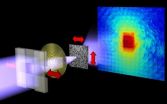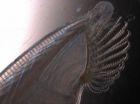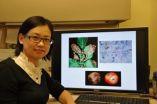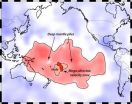Understanding microbes blowing in the wind
2013-02-07
(Press-News.org) With help from a wind tunnel and the latest DNA technology, U.S. Department of Agriculture (USDA) scientists are shedding light on the travel patterns of microbes in soils carried off by strong winds. The work has implications for soil health and could lead to management practices that minimize the damage to soils caused by wind erosion.
Wind erosion is an emerging issue in soil conservation efforts. Agricultural Research Service (ARS) scientists have been studying wind-eroded soils since the 1930s, but few studies have focused on the effects of wind on the bacteria, fungi, and protozoa in the soil. ARS is USDA's chief intramural scientific research agency.
Researchers see an increasing need to focus on pathogens and agriculturally important bacteria carried in dust. ARS soil scientist Veronica Acosta-Martinez, with the agency's Wind Erosion and Water Conservation Unit in Lubbock, Texas, focused on bacterial populations that could be classified by DNA sequencing. She worked with Terrence Gardner, a visiting scientist from Alabama A&M University.
Researchers collected airborne dust and samples of a type of organic soil susceptible to wind erosion from fields where potatoes, beets and onions had grown a few years earlier and exposed them to windy conditions using a portable wind tunnel. They characterized the bacteria they found in both the "source soils" and the wind-eroded sediments, focusing on types of bacteria associated with coarse particles and on the types associated with fine dust particles.
They classified the bacteria found in each type of soil and wind-eroded sediment using pyrosequencing, a process that allowed them to identify up to 100 times more DNA in each sample than they would have detected with traditional methods. The study results showed that certain types of bacteria, known as Bacteroidetes, were more predominant in the fine dust. Other types, known as Proteobacteria, were more predominant in coarse sediments.
Studies have shown that Bacteroidetes resist desiccation and thus can survive in extreme conditions when carried long distances. The fact that Proteobacteria were associated with coarse eroded sediments, which travel shorter distances, may explain how soils can retain important qualities despite damaging winds. Proteobacteria play an important role in carbon and nitrogen cycling, and their fate in dust storms will be the focus of future research, according to Acosta-Martinez.
###
Read more about this research in the February 2013 issue of Agricultural Research magazine.
http://www.ars.usda.gov/is/AR/archive/feb13/soil0213.htm
USDA is an equal opportunity provider and employer. To file a complaint of discrimination, write: USDA, Office of the Assistant Secretary for Civil Rights, Office of Adjudication, 1400 Independence Ave., SW, Washington, DC 20250-9410 or call (866) 632-9992 (Toll-free Customer Service), (800) 877-8339 (Local or Federal relay), (866) 377-8642 (Relay voice users).
END
ELSE PRESS RELEASES FROM THIS DATE:
2013-02-07
INDIANAPOLIS -- Medical literature long has touted the benefits of omega-3 fatty acids for the heart. But until now, researchers have not studied the potential benefit for people on hemodialysis, who are among the highest-risk patients for sudden cardiac death.
A study published Feb. 6 online in the journal Kidney International, which included 100 patients who died of sudden cardiac death during their first year of hemodialysis and 300 patients who survived, is the first to examine this question.
Allon N. Friedman, M.D., associate professor of medicine in the Division ...
2013-02-07
SAN FRANCISCO, Feb. 6, 2013 -- Nitrogen in ocean waters fuels the growth of two tiny but toxic phytoplankton species that are harmful to marine life and human health, warns a new study published in the Journal of Phycology.
Researchers from San Francisco State University found that nitrogen entering the ocean -- whether through natural processes or pollution -- boosts the growth and toxicity of a group of phytoplankton that can cause the human illness Amnesic Shellfish Poisoning.
Commonly found in marine waters off the North American West Coast, these diatoms (phytoplankton ...
2013-02-07
Since the observations made by English naturalist Charles Darwin on the Galapagos Islands, researchers have been interested in how physical barriers, such as isolation on a particular island, can lead to the formation of new species through the process of natural selection. Natural selection is a process whereby heritable traits that enhance survival become more common in successive generations, while unfavorable heritable traits become less common. Over time, animals and plants that have morphologies or other attributes that enhance their suitability to a particular environment ...
2013-02-07
ANN ARBOR—Hunger, thirst, stress and drugs can create a change in the brain that transforms a repulsive feeling into a strong positive "wanting," a new University of Michigan study indicates.
The research used salt appetite to show how powerful natural mechanisms of brain desires can instantly transform a cue that always predicted a repulsive Dead Sea Salt solution into an eagerly wanted beacon or motivational magnet.
Mike Robinson, a research fellow in the U-M Department of Psychology and the study's lead author, said the findings help explain how related brain activations ...
2013-02-07
AUDIO:
In the 1970s and early 1980s, some states lower their minimum legal drinking age below the age of 21. Those lower drinking ages have been linked to bad things, from...
Click here for more information.
People who grew up in states where it was legal to drink alcohol before age 21 are more likely to be binge drinkers later in life, according to a study by researchers at Washington University School of Medicine in St. Louis.
The findings are available online in Alcoholism: ...
2013-02-07
For more than 100 years radiography meant: don't move! In order to visualize nanostructures such as biological cells, the porous structure of cement or storage fields of magnetic disks, the experimentators had to avoid any kind of vibration of X-ray microscope and sample. In addition, only a small percentage fraction of the incoming X-ray radiation could be used. Using special filters, they had to select exactly the fraction with the right properties – for example, the right wavelength.
Contributions of different wavelengths separated
Pierre Thibault of the Technische ...
2013-02-07
CHICAGO -- Feeding human breast milk to very-low-birth-weight infants greatly reduces risk for sepsis and significantly lowers associated neonatal intensive care unit (NICU) costs, according to a study by Rush University Medical Center researchers.
The study, published Jan. 31 in the advance online version of the Journal of Perinatology, showed that every 10 milliliters of human milk per kilogram that a very low birth weight infant received during the first 28 days of life decreased the odds of sepsis by almost 20 percent.
A daily dose of 25 to 49.99 milliliters of ...
2013-02-07
WOODS HOLE, MASS. -- Among the animals that are appealing "cover models" for scientific journals, lancelets don't spring readily to mind. Slender, limbless, primitive blobs that look pretty much the same end to end, lancelets "are extremely boring. I wouldn't recommend them for a home aquarium," says Enrico Nasi, adjunct senior scientist at the Marine Biological Laboratory (MBL). Yet Nasi and his collaborators managed to land a lancelet on the cover of the Journal of Neuroscience last December. These simple chordates, they discovered, offer insight into our own biological ...
2013-02-07
RIVERSIDE, Calif. — When a pathogen attacks a plant, infection usually follows after the plant's immune system is compromised. A team of researchers at the University of California, Riverside focused on Phytophthora, the pathogen that triggered the Irish Famine of the 19th century by infecting potato plants, and deciphered how it succeeded in crippling the plant's immune system.
The genus Phytophthora contains many notorious pathogens of crops. Phytophthora pathogens cause worldwide losses of more than $6 billion each year on potato (Phytophthora infestans) and about ...
2013-02-07
SALT LAKE CITY, Feb. 7, 2013 – A University of Utah seismologist analyzed seismic waves that bombarded Earth's core, and believes he got a look at the earliest roots of Earth's most cataclysmic kind of volcanic eruption. But don't worry. He says it won't happen for perhaps 200 million years.
"What we may be detecting is the start of one of these large eruptive events that – if it ever happens – could cause very massive destruction on Earth," says seismologist Michael Thorne, the study's principal author and an assistant professor of geology and geophysics at the University ...
LAST 30 PRESS RELEASES:
[Press-News.org] Understanding microbes blowing in the wind





